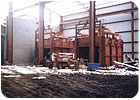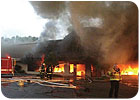
Jupiter Aluminum, Hammond, IN
Shortly after 5:30 a.m. on Nov. 24, 2006, sparks and a machine malfunction ignited a small fire inside the Jupiter Aluminum rolling mill in Hammond, IN. The massive refinery recycles scrap aluminum for production of aluminum products and produces more than half of all U.S. license plates. An oil-based kerosene mist was used to keep sheets of aluminum lubricated throughout a process, which rolls the metal into coils or plates.A video system recovered after the fire depicted the initial flames and actions of workers attempting to activate a CO2 system that served to protect the machinery. The small suppression system did not activate, however, resulting in a horrific 12-hour fire that totaled $200 million in damages. Billowing dark smoke blocked out the sun and necessitated a 2-mile shutdown of the Indiana Toll Road, located two miles from the blaze.

Two
furnaces destroyed by fire in the Jupiter Aluminum rolling mill. Photo courtesy
of www.secowarwick.com.
The purported reason for the abandoned sprinkler systems centered around the fact that under certain conditions (heat and water application), flaked or powdered aluminum can explode violently. Usage of water (or halon) is not universally recommended to fight fires involving aluminum, which rarely burns after melting at 1220°F. Dry chemical is actually the preferred suppression agent.
At Jupiter Aluminum, sparks from the rolling equipment caused several oil mist fires annually, which the CO2 systems had always smothered. The particular CO2 system protecting the faulty rolling machine had been successfully tested two days prior to the blaze, but the cause of its untimely malfunction has never been identified. The only fire sprinkler protection in the building consisted of a single wet-pipe system protecting the small two-story office section, a 2005 retrofit installation that amounted to 175 fire sprinklers.
Building construction included high bay timber trusses, tar and wooden roofs, and a creosote floor. Firemen remarked that over time, aluminum dust and oil “had attached itself to everything in the building.” Several other factors combined to make this fire the most difficult to battle in the area’s history. Most significantly, the mill is situated in a low-pressure water zone, hampering hose stream efforts and six rigs pumping simultaneously.
An 18,000-gallon tank used to hold the oil/kerosene lubricating mist caught fire and burned until 4:00 p.m. A steady 40-mph southwest wind was responsible for a roof catching fire at the adjacent International Petroleum oil-handling facility, which firefighters had to attend to. Portions of the Jupiter roof collapsed. An adjacent Jupiter structure that houses the company’s furnaces also was damaged by flames. And to top it all off, only skeleton fire crews were initially on hand because the fire occurred on the day after Thanksgiving.
Every piece of Hammond fire equipment was in use throughout the day, including their three aerial units. Necessary assistance was provided by three additional fire companies and the neighboring BP Amoco oil refinery-from which an entire tanker of fire-suppressing foam was utilized. With tools and skill, this blaze was eventually contained, but the refinery was a total loss. “It was just a bad deal that day,” remarked Insp. Kevin Margraf. “The saving grace was nobody got hurt.”

Fire
engulfs the Sofa Super Store. Photo by John Pundt, www.charleston.net.
Sofa Super Store, Charleston, SC
There was no silver lining at the Sofa Super Store fire, which occurred on June 18 of this year. Nine firefighters perished in Charleston, SC, while battling this large furniture warehouse fire. Fire department units were dispatched at 7:08 p.m. after calls came in from passing motorists. The building had no fire sprinkler system or automatic alarms, nor was it required by local building officials to have a fire sprinkler system. Investigators later determined that the fire began in the enclosed loading dock (inside a waste container) that separated the showroom from the warehouse.At 7:11 p.m., the first arriving firefighters were informed that two employees were trapped inside the building and they were rescued. Four minutes later, the fire had spread to the showroom porch, where wind-aided flames quickly ignited furniture. As two more store employees were pulled to safety, the furniture fire grew rapidly.
Furniture fires are among the most dangerous to battle. Stacked furniture is often encapsulated, palletized and separated by large pockets of air. Comprised of wood, polyurethane foam, wood lacquer and other combustible materials, furniture fires are notorious for reaching the flashover stage at comparatively low temperatures. In this case, a flashover did occur at approximately 7:25 p.m., erupting the entire showroom interior in fire and blinding smoke.
Two of the 17 firefighters inside were able to leap through the front windows to safety at that time. The front of the showroom building fell five minutes after flashover, resulting in a 30-foot tower of flames, and soon after, a major structural collapse. Although the fire was under control by 10:00 p.m., confirmation was received several hours later that the firefighter death toll was nine. While these men were found badly burned, the real cause of their demise was most likely smoke inhalation (the primary cause of death in victims or firemen caught in indoor fires) or by means of the roof collapse.
Smoke from this fire contained an inordinate amount of dangerous fumes, toxic vapors, particulate matter and gases. This is an extreme instance of rapid fire spread leading to an unexpected flashover, which led to disaster. A senior official at the scene, Asst. Fire Chief Larry Garvin, said, “In 34 years of fire service, I’ve never seen a fire travel that fast with that magnitude.”
Charleston is an old town. In 1790, it was the fourth-largest city in the United States. What has resonated with the public there is that the awful tragic events of June 18 were something preventable, and should not have happened. The U.S. Fire Administration is currently performing a complete study to analyze, in the words of USFA administrator Ken Farmer, “how a fairly simple fire turned so ugly.”
On July 25, Charleston Water System commissioners discontinued their policy of charging businesses any water connection fees. Previously, a commercial enterprise would have been charged $52,000 to tap a 6-inch feed line into the city water main. The city hopes that with that charge eliminated, businesses will be encouraged to retrofit their buildings with fire sprinkler systems.
Also, the monthly utility charges for a typical sprinkler line would be reduced by 80% for all businesses under the newly adopted plan. While the utility estimates that these changes may cost them as much as $3 million annually, Chairman Thomas Pritchard is hopeful that business owners will be induced to sprinkler their properties. “We’ve eliminated an excuse,” he remarked. “I hope people won’t hide behind the cost of actually installing a fire suppression system.”
Two of the brave rescuers who lost their lives while assisting those in peril, Brandon Thompson and Michael French, were just 27 years old. It is heartbreaking. Charleston Mayor Joe Riley called them heroes. At a news conference, he stated, “This is a profession that we must never take for granted; there’s a fire raging and they go toward it.”
In 1956, 19 firefighters were killed at the Shamrock Oil refinery in Sun Ray, TX. More recent line-of-duty deaths (LODD) in atrocious numbers occurred during a 1972 wall collapse at the Hotel Vendome in Boston (nine firemen killed), the 1999 fire at the Worcester (MA) Cold Storage Warehouse (rapid fire spread, six brothers lost) and the June 17, 2001, warehouse fire in New York City in which three firemen perished in an explosion.
We Can Thwart Tragedy
While the NFPA meticulously documents statistics regarding firefighter fatalities, it would be both of value and a blessing if they were to collect and publish data detailing instances where fire sprinkler systems extinguish fires. That crucial event of sprinkler system operation saves lives, but it does not make mainstream media news, nor is it among the collected fire data from which many building codes are based. The clear fact remains that there has never been a multiple loss of life in a fully sprinklered building. When fire sprinklers activate, their performance record is virtually 100%. Fires happen every day in this country, and automatic fire sprinkler systems are containing and extinguishing those fires every day.
Fires that occur in unsprinklered structures on windy days are relentless and unforgiving. This is where the devil dances. Older buildings, “grandfathered” in prior to fire code legislation, are rarely retrofitted with fire sprinkler systems because no one wants to spend money, which they conclude will bring “no return.” Ignoring the fact that these systems pay for themselves over time with reduced insurance premiums, building owners balk at the cost of something that will avert a deadly fire. But what is the cost of a life?